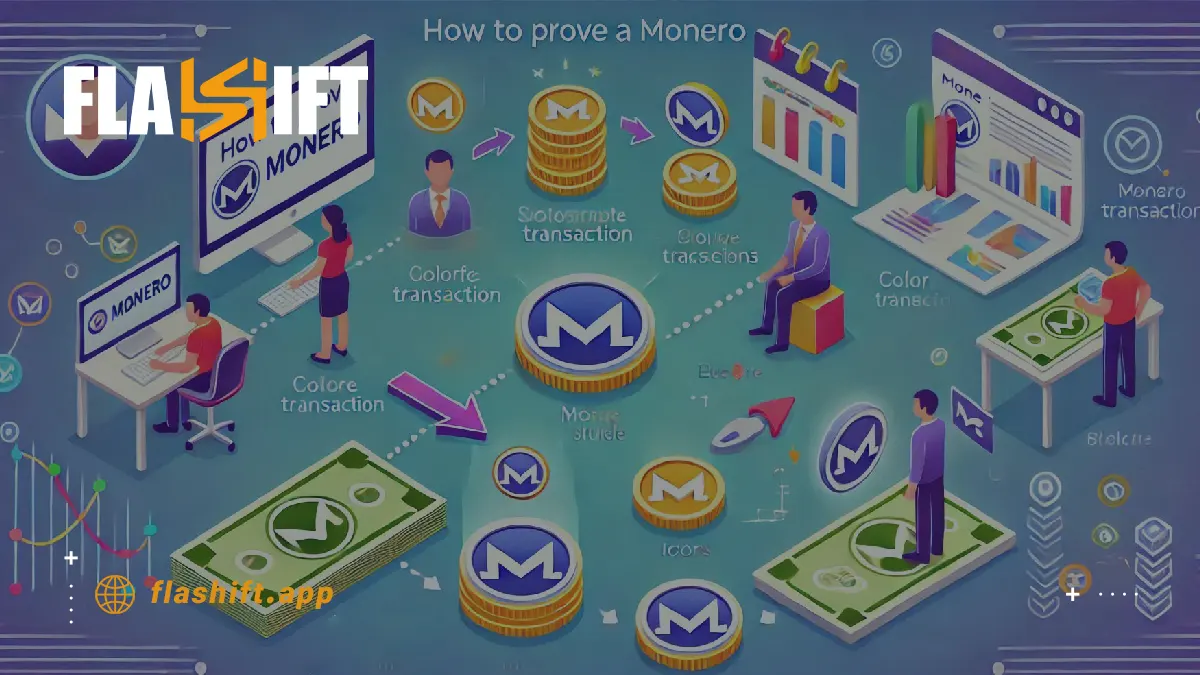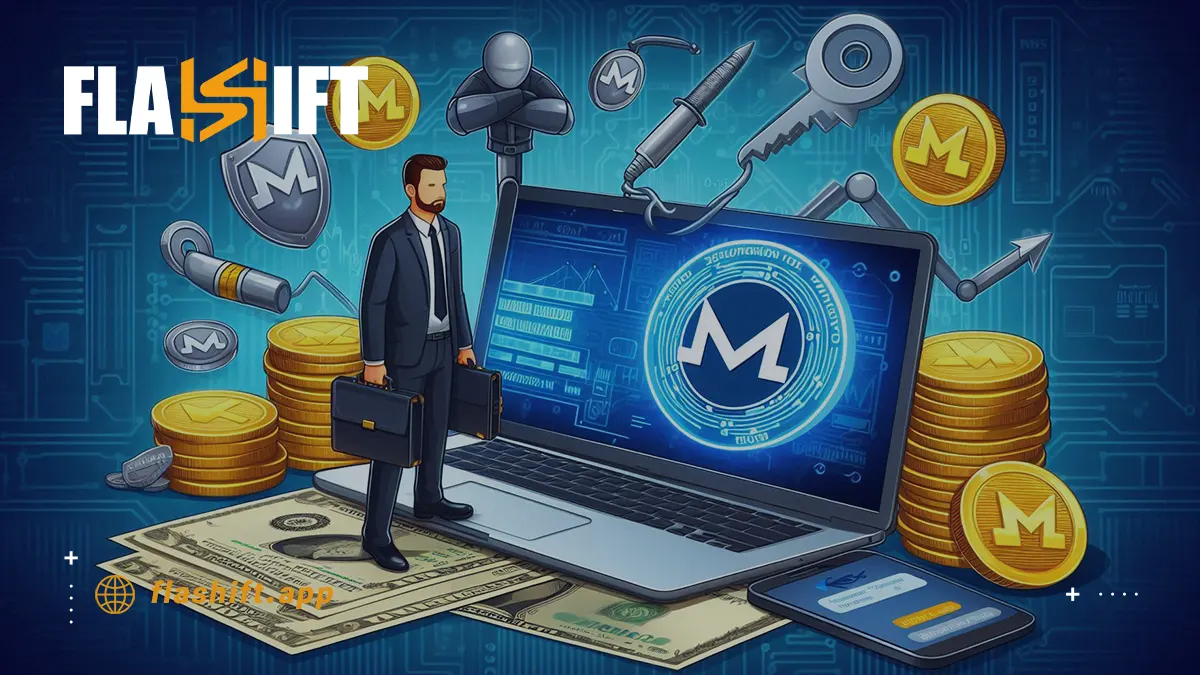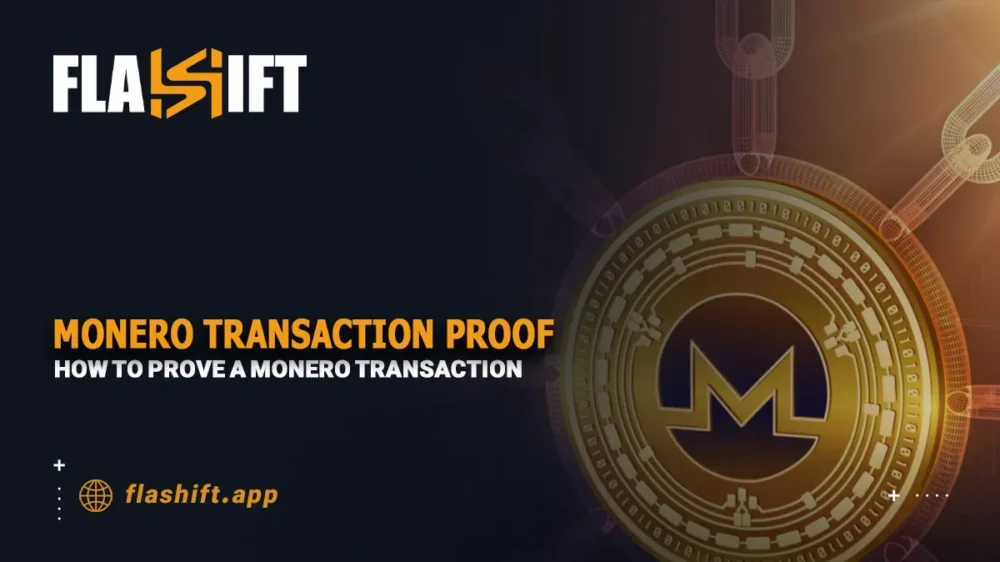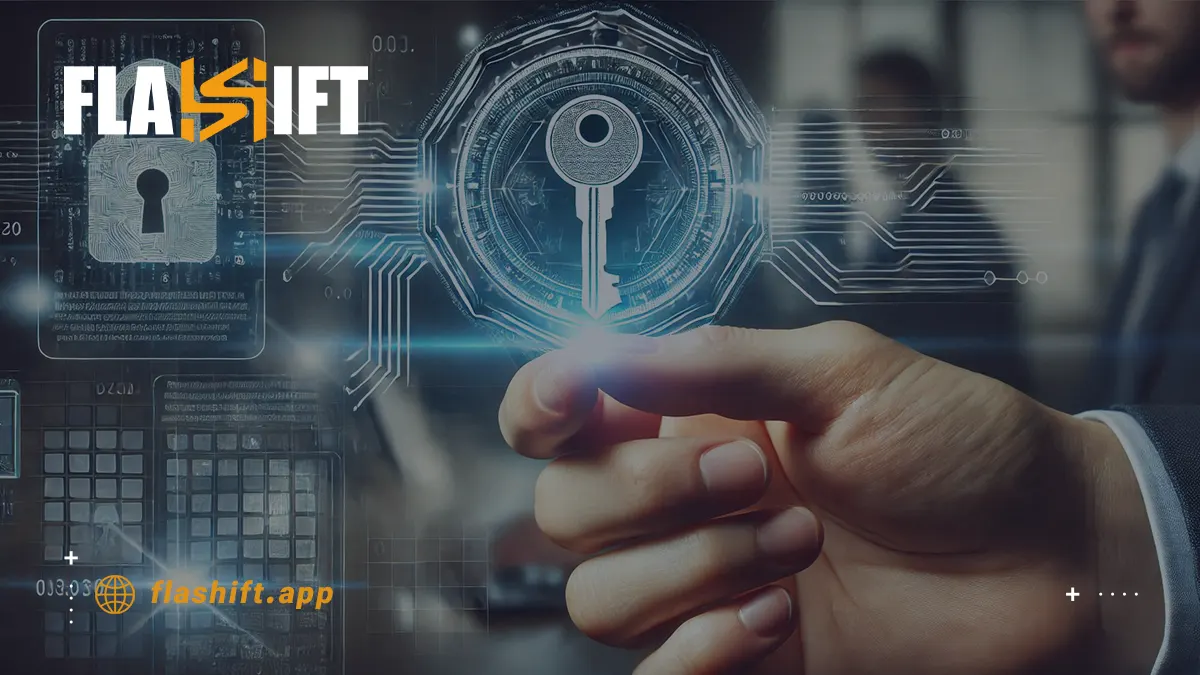How to prove a Monero transaction | Proving a Monero transaction is rather unique in that this cryptocurrency emphasizes privacy and anonymity. While traditional cryptocurrencies, such as Bitcoin, do not have the advanced cryptographic techniques to hide sender, receiver, and amount details of the transaction, Monero does. However, there are ways to prove the existence of a transaction and the validity of such.
In this guide, we will explore “how you can prove a Monero transaction” in Monero trading, while protecting the privacy features that made this cryptocurrency unique. Understanding exactly how to prove transactions in Monero is important for complete transparency and security, not just for investors but also users.
Introduction to Monero Transaction Proofs
Understanding Monero transactions inherently proves how this privacy-centered cryptocurrency works. While other cryptocurrencies, such as Bitcoin, are designed to be transparent, Monero deploys advanced cryptographic techniques like Ring Signatures and Stealth Addresses that will keep the sender and recipient, together with the amount of the transaction, private. This is what makes the nature of Monero transaction proof different in that typical details of a transaction are obfuscated.
While privacy is a core feature of Monero, there are still ways to prove the legitimacy of a transaction without compromising these privacy elements. Proving a Monero transaction is important for verifying that a transaction was validly processed, ensuring trust in peer-to-peer exchanges, and satisfying audit requirements, all while maintaining confidentiality in the manner Monero is known for. Understanding this process is crucial for both users and investors looking to maintain secure and private transactions.
What is a Monero Transaction Proof?
A Monero transaction proof is a cryptographic manner of confirming that a Monero transfer has taken place without actually divulging sensitive information with regard to the actual transaction. Monero’s privacy features, like Ring Signatures and Stealth Addresses, protect the details of the transactions, but allow users to verify that a transaction actually happened.
Proof of payment in Monero is a construction serving as an assurance for the recipient that the payment actually took place, without disclosing the identity of the sender or the amount of the transaction. This may be crucial for ensuring trust in a peer-to-peer exchange, dispute resolution, or auditing requirements.
When and Why You Might Need to Prove a Monero Payment
There are several situations where verifying Monero transactions or proving a Monero payment is necessary:
- Dispute Resolution: If there’s a dispute regarding whether a payment was made, Monero transaction verification provides proof of payment without compromising privacy.
- Business Transactions: Merchants or businesses may need to prove that a payment has been received while protecting customer information.
- Auditing: For compliance or personal record-keeping, you may need to verify Monero transaction hash to confirm that a transaction occurred.
To prove a Monero transfer, you typically use the Monero transaction key for proof, which allows you to share a proof without exposing any private details. This Monero proof-of-payment guide shows you how to confirm the transaction was successful while maintaining privacy through the Monero transaction confirmation process.
Read More: Monero Mining: A Beginner’s Guide to Privacy-Centric Mining
How to Prove a Monero Transaction: Step-by-Step

Proving a Monero transaction can be done either using the Monero GUI wallet or the Monero CLI. Both methods allow users to generate a proof-of-payment without compromising the privacy of the transaction. Here’s a step-by-step guide for both methods:
1. Using Monero GUI Wallet to Generate a Proof
The Monero GUI Wallet provides an easy way to generate a proof for your transaction. Here’s how:
Step-by-Step Process:
- Open the Monero GUI Wallet: Launch the wallet and make sure it’s synchronized with the blockchain.
- Go to the “Transactions” Tab: Locate the transaction for which you need the proof. This can be found in your transaction history.
- Select the Transaction: Click on the specific transaction you wish to generate the proof for.
- Generate Proof: Click on the “Generate Proof” button. You will be prompted to choose whether you want a proof of payment or proof of inclusion.
- Save or Share the Proof: The proof will be generated as a file that you can save or share with the recipient. This will include the necessary details for verification but will not reveal any private information.
This process ensures that the transaction is confirmed without revealing sensitive details like the sender or the amount.
2. How to Create a Transaction Proof in Monero CLI
If you’re comfortable with the command line, the Monero CLI provides a powerful and flexible way to generate a transaction proof.
Step-by-Step Process:
- Open the Monero CLI: Launch the Monero Command Line Interface (CLI) and make sure your wallet is synchronized.
- Use the ‘prove’ Command: To generate a proof of your transaction, use the following command:
prove_tx <tx_id> <view_key> <spend_key> –output proof.txt
| <tx_id>: | The transaction ID of the transaction you want to prove. |
| <view_key>: | Your Monero wallet view key. |
| <spend_key>: | Your Monero wallet spend key. |
- Save the Proof: The proof will be saved as a .txt file (or whatever file format you specify) in the current directory.
- Share the Proof: You can share this proof file with the recipient or verifier to confirm the transaction.
This method gives you a more detailed, flexible way to generate proofs, ideal for users familiar with CLI tools.
3. Verifying a Proof-of-Payment with Monero Tools
To verify a Monero transaction proof, you can use Monero’s various tools, including the Monero CLI or Monero GUI Wallet.
Verification in Monero GUI Wallet:
- Open the Monero GUI Wallet: Ensure your wallet is fully synced.
- Navigate to the “Tools” Menu: Look for an option like “Verify Transaction Proof.”
- Upload the Proof: Select the proof file generated by the sender.
- Verify the Transaction: The wallet will automatically check the proof and inform you whether it’s valid or not.
Verification in Monero CLI:
- Use the ‘verify’ Command: Open the Monero CLI and use the following command to verify the proof:
2. verify_tx_proof <proof_file>
- Check the Output: The CLI will return a message indicating whether the proof is valid and the transaction has been successfully verified.
Conclusion
Proving a Monero transaction is straightforward whether you use the Monero GUI wallet or the Monero CLI. Both methods offer a way to confirm Monero proof-of-payment while maintaining privacy, ensuring that no sensitive transaction details are exposed. By following these steps, you can easily verify Monero transactions or provide proof of payment for your Monero transfers.
Using a Transaction Key for Verification
What is a Transaction Key in Monero?
A transaction key in Monero is a unique cryptographic key associated with each transaction. It is generated when a transaction is created and allows users to verify Monero transactions without revealing sensitive details such as the sender, receiver, or the transaction amount. The transaction key is essential for proving the legitimacy of a Monero payment or verifying the Monero transaction hash.
The transaction key is split into two components:
- Tx key: Used to prove the transaction’s authenticity.
- View key: Allows you to view incoming transactions and verify their details.
How to Use a Transaction Key to Verify a Payment
To prove a Monero payment or verify Monero transactions, the transaction key can be used in the following steps:
- Obtain the Transaction Key: The transaction key is typically available in your Monero wallet after you send or receive a transaction. It may be accessed through the Monero GUI wallet or CLI.
- Share the Transaction Key: Provide the transaction key to the party that needs to verify the payment. This allows them to check the transaction without compromising privacy.
- Use the Transaction Key for Proof: With the transaction key, the verifier can use tools like the Monero CLI or GUI wallet to validate the transaction by checking the transaction hash and confirming that the transaction was valid.
- Verify the Payment: The verifier uses the transaction key to confirm that the payment was made, ensuring the transaction is legitimate, recorded on the blockchain, and hasn’t been tampered with.
Verifying with Monero Tools
- Monero GUI Wallet: In the wallet, navigate to the “Tools” section and select the option to verify transaction proof. Upload the proof file generated using the transaction key, and the wallet will confirm the payment.
- Monero CLI: Use the following command to verify the transaction:
· verify_tx_proof <proof_file>
This command checks the integrity of the proof using the transaction key, ensuring that the payment is valid and was indeed made.
Last Words
Using the Monero transaction key for proof is a secure and private method of verifying Monero transactions and proving Monero payments. The transaction key allows verification without exposing sensitive information, such as transaction amounts or sender/receiver details. By following the Monero proof-of-payment guide, users can easily prove a Monero transfer and confirm the legitimacy of their transactions.
Common Scenarios for Monero Transaction Proofs
1. Proving a Payment to a Merchant or Service Provider
One of the most common scenarios for generating a Monero transaction proof is when you need to prove a Monero payment to a merchant or service provider. Since Monero’s privacy features obscure transaction details like the sender’s identity and the payment amount, using a proof-of-payment ensures the merchant that the payment was made without revealing sensitive information.
For example, if you pay for a product or service with Monero and the merchant asks for verification, you can generate a proof by sharing the transaction key or a proof file. This confirms that the transaction was valid and completed successfully, while keeping the transaction’s private details secure.
2. Resolving Disputes with Transaction Verification
Another common scenario for using Monero transaction verification is when there’s a dispute regarding a payment. If a recipient claims they didn’t receive a payment, you can provide a transaction proof to show that the transaction took place. This is especially useful in peer-to-peer exchanges or between users who may not know each other well.
By using the Monero transaction key for proof, you can share a verified record of the transaction without compromising your privacy. This method ensures that both parties can confirm the legitimacy of the transaction, avoiding unnecessary disputes and fostering trust.
Whether you’re dealing with a merchant or resolving a payment dispute, Monero transaction proofs provide an efficient and secure way to verify Monero transactions. These proofs maintain privacy while ensuring the legitimacy of the payment, making them an essential tool for users in various scenarios.
Best Tools for Verifying Monero Transactions

Verifying Monero transactions can be done using both official and third-party tools that help ensure a transaction’s authenticity while maintaining privacy. These tools are crucial for verifying Monero transaction proofs, proof-of-payment, and confirming that transactions are legitimate.
1. Monero Blockchain Explorers
Monero, due to its privacy features, doesn’t have traditional blockchain explorers like Bitcoin. However, there are a few specialized Monero blockchain explorers that allow users to verify certain aspects of a transaction:
- info: This is one of the most commonly used explorers for Monero. It allows users to search for blocks, transactions, and addresses. However, due to Monero’s privacy features, it won’t show complete transaction details but can confirm whether a transaction exists.
- XMRChain: This is another Monero explorer that allows users to search for Monero transactions, block data, and addresses. Similar to MoneroBlocks, it provides high-level information, but privacy features still limit detailed visibility.
2. Official Monero Tools
- Monero GUI Wallet: The official Monero GUI wallet has built-in functionality to verify Monero transactions. Users can generate a proof-of-payment directly within the wallet, which provides transaction verification without revealing sensitive information.
- Monero CLI: The Monero Command Line Interface is another official tool that allows advanced users to verify Monero transactions. Through the CLI, users can generate transaction proofs using the transaction key and verify payments securely.
3. Third-Party Verification Tools
Several third-party tools can also help with verifying Monero transactions:
- Blockchair: Although Blockchair primarily focuses on more public blockchains, it offers some level of Monero transaction It can give insights into transactions but is limited in terms of privacy due to Monero’s confidentiality features.
- Monero Audit Tools: Some specialized third-party tools, such as Monero Audit, are used by businesses or developers to verify payments in Monero. These tools are designed to maintain privacy while providing enough data to verify the transaction’s legitimacy.
Final Thoughts
While Monero is designed for privacy and confidentiality, there are several tools for verifying Monero transactions. These include both official options like the Monero GUI Wallet and CLI, as well as third-party blockchain explorers and audit tools. Depending on your needs, these tools can help you confirm proof-of-payment and ensure your Monero transaction verification process is secure and trustworthy.
Read More: Monero vs Bitcoin: A Deep Dive into Privacy and Security
Troubleshooting Monero Transaction Verification Issues
While verifying Monero transactions is usually straightforward, sometimes issues may arise, especially when generating transaction proofs or handling transaction keys. Here are some common problems and their solutions.
1. What to Do If You Can’t Generate a Transaction Proof
If you’re having trouble generating a Monero transaction proof, it could be due to several reasons:
- Wallet Not Synced: Ensure your Monero wallet is fully synced with the blockchain. If your wallet isn’t up-to-date, it may prevent you from accessing the required transaction information. Try waiting for synchronization or manually updating your wallet.
- Missing Transaction Details: If the transaction is not appearing in your wallet’s transaction history, you may not have access to the transaction key needed for generating the proof. Make sure the transaction was successfully completed and is visible in the Monero GUI wallet or CLI.
- Incorrect Wallet Configuration: If you’re using the Monero CLI and have trouble generating the proof, double-check that you’re using the correct transaction key, view key, and spend key. Incorrect configurations can lead to errors when generating a proof.
- Solution: Double-check the wallet settings, synchronize the wallet, and ensure you’re using the right keys to generate the proof. You may also want to try generating the proof again from a different interface, such as the Monero GUI wallet.
2. Handling Missing or Incorrect Transaction Keys
If you’re unable to generate a proof or verify a Monero payment due to missing or incorrect transaction keys, here’s what you can do:
- Verify Key Availability: Ensure you have the correct transaction key (which is different from the view key and spend key) for the specific transaction. If you don’t have the correct key, you won’t be able to prove the transaction.
- Check Your Wallet: The transaction key should be available in your Monero wallet. If you’re using the Monero GUI wallet or CLI, you should be able to retrieve the transaction key directly from the wallet’s transaction history.
- Lost Transaction Key: If you’ve lost the transaction key, recovery becomes difficult. Monero transactions are private, so without the key, you may not be able to generate a proof for the transaction. Always back up your wallet’s private keys securely to avoid this issue.
- Solution: If the transaction key is missing, try searching through your backup or wallet settings. If you cannot locate it, you might need to reach out to the recipient or check with the platform you transacted with to see if they can help.
In Summary
Troubleshooting Monero transaction verification issues typically involves ensuring that your wallet is synced, that you have the correct transaction key, and that you’re following the right procedures for generating transaction proofs. By addressing issues such as missing or incorrect keys, and syncing your wallet, you can easily resolve most verification problems and maintain secure, private transactions.
Security Tips for Monero Transactions and Proofs

Ensuring the security of your Monero transactions and proofs-of-payment is crucial, as Monero’s privacy features make it a target for phishing attacks and fraud. Here are some essential security tips to safeguard your Monero transaction proof and keys:
1. Keeping Your Transaction Keys Secure
Your monero transaction key is the most important piece of data for verifying a Monero payment. If compromised, it could allow unauthorized parties to falsify transaction proofs or access sensitive information.
- Store Keys Offline: Always keep your transaction keys in a secure, offline location (e.g., hardware wallets or encrypted USB drives) to protect against hacking or online threats.
- Use Strong Passwords: If you store your keys in a digital format (such as a password manager), ensure your passwords are strong and unique to prevent unauthorized access.
- Backup Your Keys: Always create encrypted backups of your transaction keys, view keys, and spend keys in multiple secure locations. Losing them can make it impossible to verify past transactions.
- Use Hardware Wallets: For added security, store your Monero wallet and keys in a hardware wallet like Ledger or Trezor. This ensures that your keys are kept off the internet and protected from malware.
2. Avoiding Phishing Attacks and Fraud While Sharing Proofs
When sharing Monero transaction proofs, it’s essential to protect yourself from phishing and fraudulent activities. Fraudsters may attempt to trick you into sharing your keys or personal details.
- Verify Recipients: Always double-check the identity of anyone requesting Monero proof-of-payment or transaction details. Make sure you trust the recipient before sharing any information.
- Don’t Share Private Keys: Never share your private keys (e.g., view keys and spend keys) with anyone. Only share transaction proofs or transaction hashes. Exposing private keys can lead to the loss of your funds.
- Check URLs Carefully: Ensure you are using trusted websites and platforms when verifying or sharing Monero proofs. Be cautious of URLs that look suspicious or unfamiliar, as these might be phishing sites designed to steal your data.
- Use Encrypted Communication: If you need to share transaction details or proofs, use encrypted communication methods such as PGP email encryption or trusted messaging apps that offer end-to-end encryption (e.g., Signal).
3. Be Cautious of Scams
Monero’s privacy features attract scammers looking to exploit unknowing users. Here’s how to avoid falling victim to scams:
- Research Before Trusting: Before engaging in any Monero transactions or sharing proof with strangers, research the platform or individual to ensure they are legitimate.
- Beware of Unrealistic Promises: Scammers often lure users with “too good to be true” offers. Be suspicious of anyone promising unusually high returns or pressuring you to share your transaction details.
The Bottom Line
Securing your Monero transaction proof and keeping your keys safe is critical for maintaining privacy and protecting your funds. By storing keys offline, using secure backup methods, and avoiding phishing and fraudulent schemes, you can ensure that your Monero transactions remain secure and your privacy is upheld. Always take the necessary precautions when sharing or verifying Monero transaction proofs to stay safe in the crypto world.
FAQ
- What is a Monero Transaction Proof?
A Monero transaction proof confirms that a transaction occurred without revealing details like the sender, amount, or recipient, ensuring privacy.
- Why Would I Need to Prove a Monero Payment?
You might need to prove a Monero payment to verify that a transaction was made, typically for businesses or exchanges.
- How Can I Generate a Proof for a Monero Transaction?
Use the Monero GUI Wallet or CLI. In the GUI, select the option in the transaction history, or use the prove_tx command in the CLI.
- What Information Does a Monero Transaction Proof Reveal?
It confirms the transaction’s validity without exposing sensitive details like the amount, sender, or recipient.
- How Do I Verify a Monero Transaction Proof?
Use the Monero GUI Wallet or CLI. In the GUI, select “Verify Transaction Proof,” or use the verify_tx_proof command in the CLI.
- What Should I Do if I Lose My Transaction Key or Proof?
If you lose your transaction key or proof, you cannot verify past transactions. Always back up your keys securely to prevent this issue.







